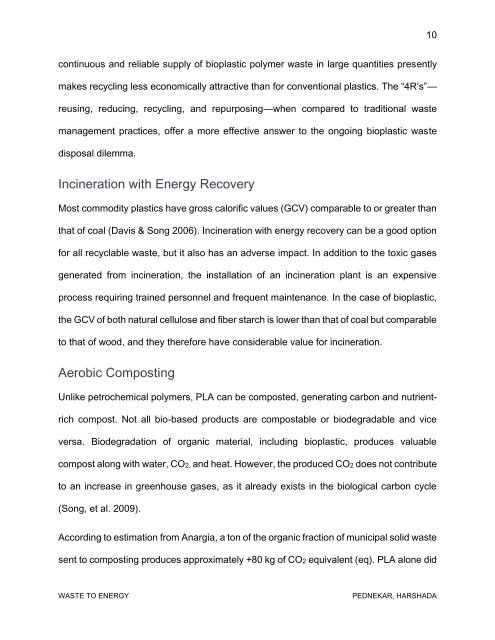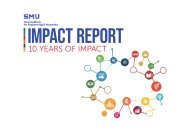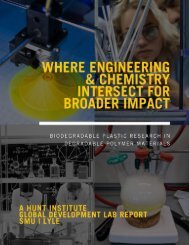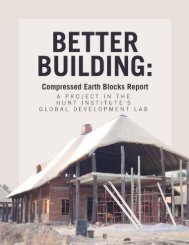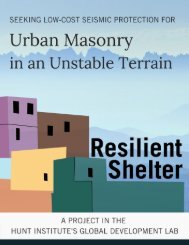Waste to Energy: Harnessing the fuel in organic waste to create a business opportunity for a recycling-based society and system
To generate a feasible amount of methane to support a digester, it is estimated that 10 to 12 tons/d, with 8-10% contamination and 80% of the contamination being bioplastics, can produce about 70 Nm3/h of biogas. This is the amount of biogas needed to produce 200 kg/day of hydrogen, which is the smallest commercially available packaged system. The greenhouse gas emission (GHG) for IngeoTM is currently 1.3 kg CO2 eq./kg polymer compared to approx. 3.2 kg CO2 eq./kg polymer for PET. Therefore, implementing anaerobic digestion for PLA can reduce around 942.5 kg - 1132 kg per day of CO2 equivalent emissions. A total of 1 ton per day of undigested bioplastic with 30% of total solids will be sent to landfills; 3 tons per day of dewatered digestate cake can be utilized for composting, and Class A fertilizer can be produced. The research on anaerobic degradation of biopolymers is still in its infancy. Therefore, this report has discussed different pre-treatment alternatives to treat PLA such as physical, chemical, and thermal treatments. This report suggests on-site segregation benefits of the current solid waste management scenario in the commercial sector of Plano, Texas. Organic waste generated from a cafeteria of the commercial sector in Plano caused an environmental impact on landfills. This report consists of a description of existing scenarios and possible pre-treatment alternatives for bioplastic degradation generated from the commercial sector. Harshada Pednekar was a graduate research analyst in the Hunt Institute while studying for a masters degree in environmental engineering from SMU's Lyle School of Engineering
To generate a feasible amount of methane to support a digester, it is estimated that 10 to 12 tons/d, with 8-10% contamination and 80% of the contamination being bioplastics, can produce about 70 Nm3/h of biogas. This is the amount of biogas needed to produce 200 kg/day of hydrogen, which is the smallest commercially available packaged system. The greenhouse gas emission (GHG) for IngeoTM is currently 1.3 kg CO2 eq./kg polymer compared to approx. 3.2 kg CO2 eq./kg polymer for PET. Therefore, implementing anaerobic digestion for PLA can reduce around 942.5 kg - 1132 kg per day of CO2 equivalent emissions.
A total of 1 ton per day of undigested bioplastic with 30% of total solids will be sent to landfills; 3 tons per day of dewatered digestate cake can be utilized for composting, and Class A fertilizer can be produced. The research on anaerobic degradation of biopolymers is still in its infancy. Therefore, this report has discussed different pre-treatment alternatives to treat PLA such as physical, chemical, and thermal treatments. This report suggests on-site segregation benefits of the current solid waste management scenario in the commercial sector of Plano, Texas. Organic waste generated from a cafeteria of the commercial sector in Plano caused an environmental impact on landfills. This report consists of a description of existing scenarios and possible pre-treatment alternatives for bioplastic degradation generated from the commercial sector.
Harshada Pednekar was a graduate research analyst in the Hunt Institute while studying for a masters degree in environmental engineering from SMU's Lyle School of Engineering
Create successful ePaper yourself
Turn your PDF publications into a flip-book with our unique Google optimized e-Paper software.
10<br />
cont<strong>in</strong>uous <strong>and</strong> reliable supply of bioplastic polymer <strong>waste</strong> <strong>in</strong> large quantities presently<br />
makes recycl<strong>in</strong>g less economically attractive than <strong>for</strong> conventional plastics. The “4R’s”—<br />
reus<strong>in</strong>g, reduc<strong>in</strong>g, recycl<strong>in</strong>g, <strong>and</strong> repurpos<strong>in</strong>g—when compared <strong>to</strong> traditional <strong>waste</strong><br />
management practices, offer a more effective answer <strong>to</strong> <strong>the</strong> ongo<strong>in</strong>g bioplastic <strong>waste</strong><br />
disposal dilemma.<br />
Inc<strong>in</strong>eration with <strong>Energy</strong> Recovery<br />
Most commodity plastics have gross calorific values (GCV) comparable <strong>to</strong> or greater than<br />
that of coal (Davis & Song 2006). Inc<strong>in</strong>eration with energy recovery can be a good option<br />
<strong>for</strong> all recyclable <strong>waste</strong>, but it also has an adverse impact. In addition <strong>to</strong> <strong>the</strong> <strong>to</strong>xic gases<br />
generated from <strong>in</strong>c<strong>in</strong>eration, <strong>the</strong> <strong>in</strong>stallation of an <strong>in</strong>c<strong>in</strong>eration plant is an expensive<br />
process requir<strong>in</strong>g tra<strong>in</strong>ed personnel <strong>and</strong> frequent ma<strong>in</strong>tenance. In <strong>the</strong> case of bioplastic,<br />
<strong>the</strong> GCV of both natural cellulose <strong>and</strong> fiber starch is lower than that of coal but comparable<br />
<strong>to</strong> that of wood, <strong>and</strong> <strong>the</strong>y <strong>the</strong>re<strong>for</strong>e have considerable value <strong>for</strong> <strong>in</strong>c<strong>in</strong>eration.<br />
Aerobic Compost<strong>in</strong>g<br />
Unlike petrochemical polymers, PLA can be composted, generat<strong>in</strong>g carbon <strong>and</strong> nutrientrich<br />
compost. Not all bio-<strong>based</strong> products are compostable or biodegradable <strong>and</strong> vice<br />
versa. Biodegradation of <strong>organic</strong> material, <strong>in</strong>clud<strong>in</strong>g bioplastic, produces valuable<br />
compost along with water, CO2, <strong>and</strong> heat. However, <strong>the</strong> produced CO2 does not contribute<br />
<strong>to</strong> an <strong>in</strong>crease <strong>in</strong> greenhouse gases, as it already exists <strong>in</strong> <strong>the</strong> biological carbon cycle<br />
(Song, et al. 2009).<br />
Accord<strong>in</strong>g <strong>to</strong> estimation from Anargia, a <strong>to</strong>n of <strong>the</strong> <strong>organic</strong> fraction of municipal solid <strong>waste</strong><br />
sent <strong>to</strong> compost<strong>in</strong>g produces approximately +80 kg of CO2 equivalent (eq). PLA alone did<br />
WASTE TO ENERGY<br />
PEDNEKAR, HARSHADA


